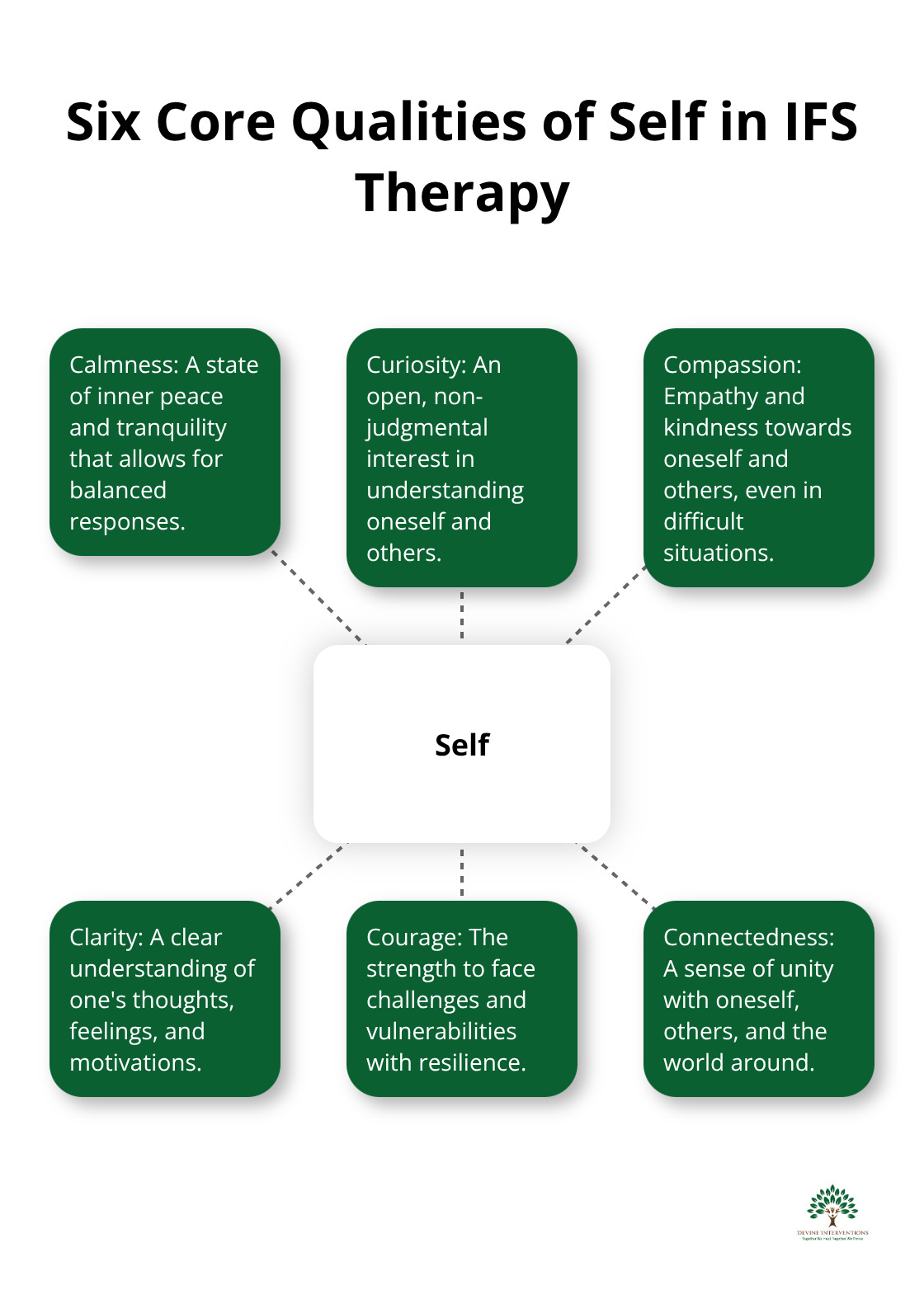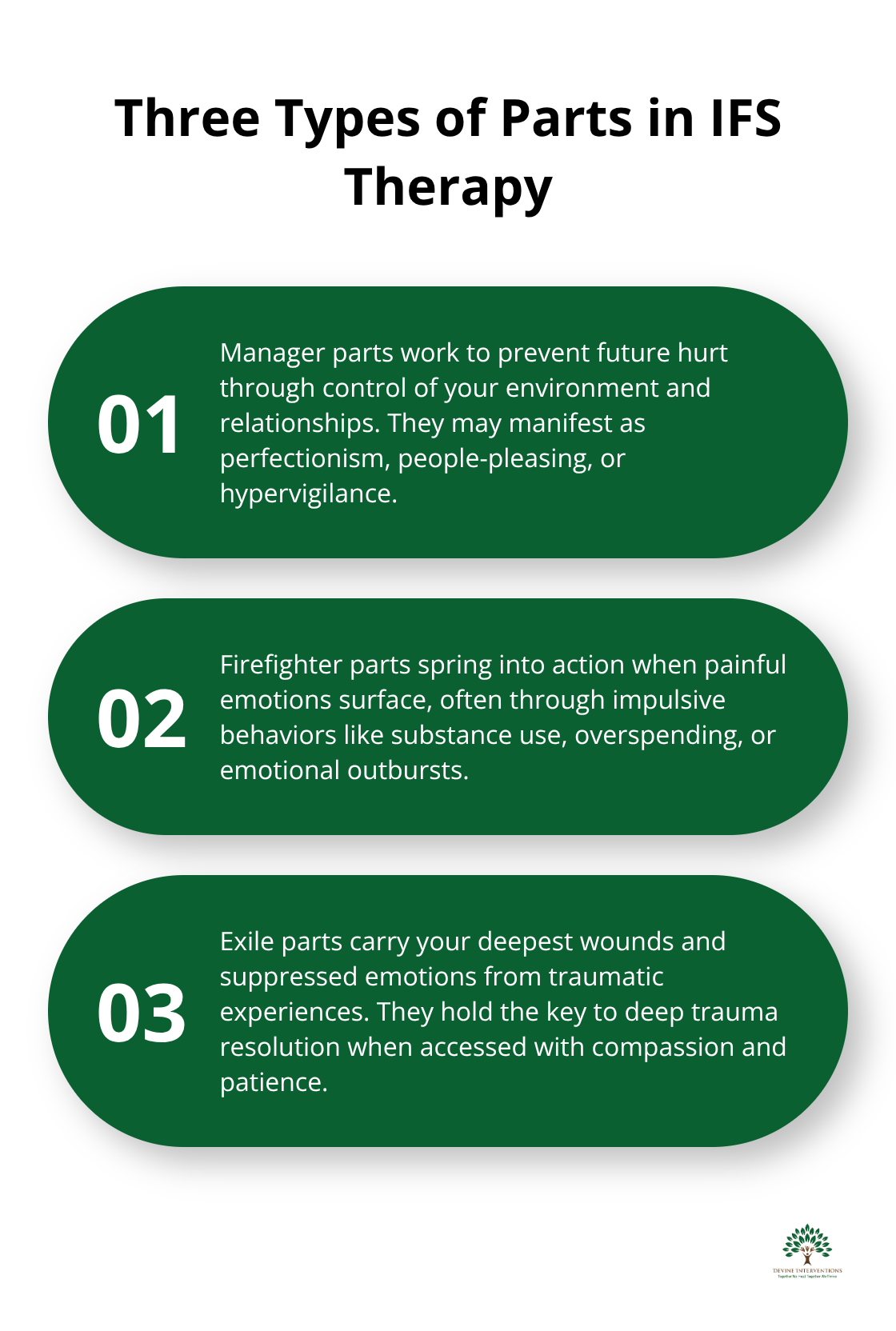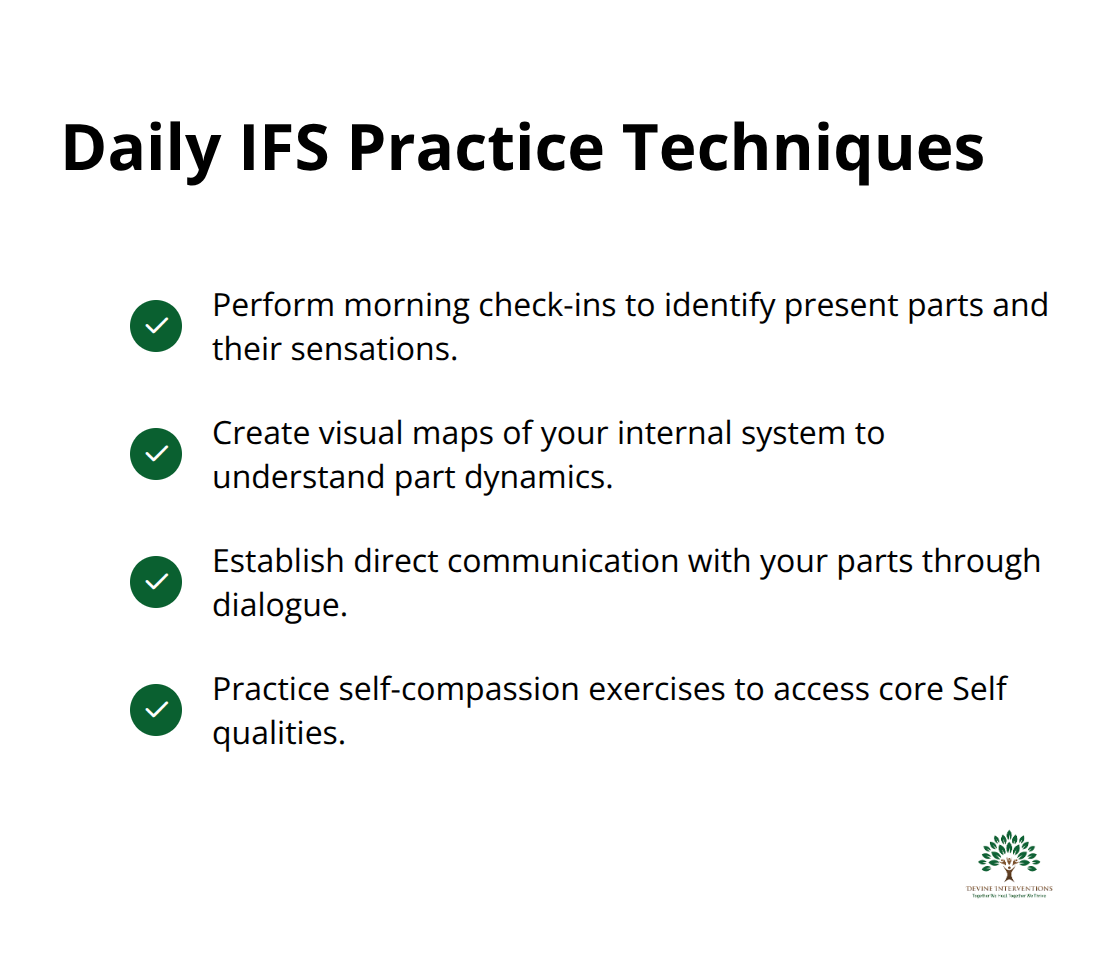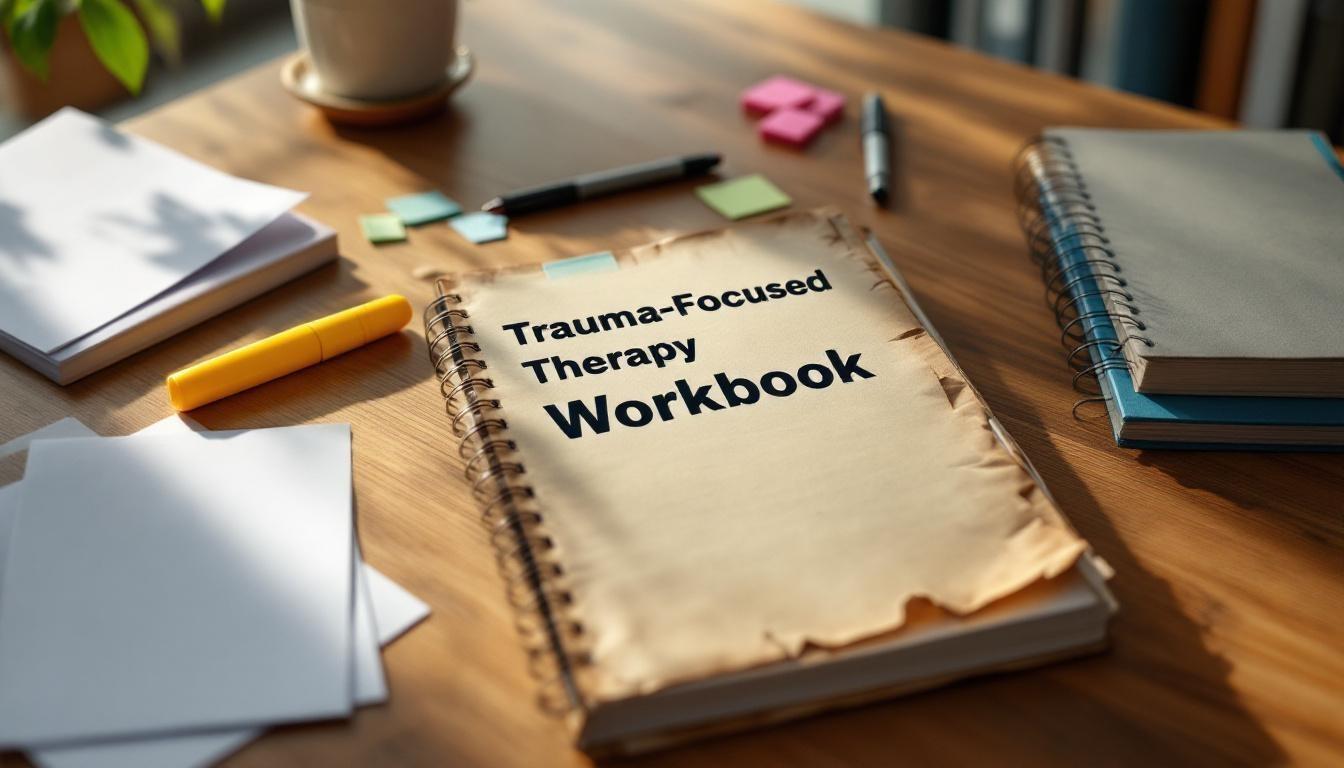Trauma can fragment our inner world, creating protective barriers that once served us but now limit our healing. Internal Family Systems therapy for trauma offers a revolutionary approach to understanding these different parts of ourselves.
At Devine Interventions, we’ve seen how IFS helps people reconnect with their authentic self while honoring the protective roles their parts have played. This therapeutic model transforms the relationship you have with your own internal system.
What Makes IFS Different From Traditional Therapy
Internal Family Systems therapy operates on a fundamental principle that revolutionizes trauma recovery: you already possess everything needed for healing within your core Self. Research from Hodgon and colleagues in 2021 shows that adults with childhood trauma experienced significant decreases in PTSD and depression symptoms through IFS therapy. This approach recognizes that your mind naturally organizes into distinct parts, each with protective functions developed through life experiences. Your Self embodies eight core qualities – calmness, curiosity, confidence, compassion, creativity, clarity, courage, and connectedness – that remain intact even after trauma.

Your Internal System Contains Three Types of Parts
Manager parts work tirelessly to prevent future hurt through control of your environment and relationships. These parts might manifest as perfectionism, people-pleasing, or hypervigilance. Firefighter parts spring into action when painful emotions surface, often through impulsive behaviors like substance use, overspending, or emotional outbursts. Exile parts carry your deepest wounds and suppressed emotions from traumatic experiences. A 2016 study by Haddock found IFS as effective as cognitive behavioral therapy for depression symptom reduction, specifically because it addresses these exile parts that traditional therapies often overlook.

Trauma Creates Protective Barriers That Block Self-Leadership
When trauma occurs, your protective parts take over to keep you safe, but they often remain hyperactive long after the danger passes. These parts form rigid patterns that disconnect you from your Self and create internal conflict and emotional numbness. The process involves helping these parts trust your Self to lead, which allows them to step back from their extreme protective roles. This shift from parts-led to Self-led existence creates space for authentic recovery and sustainable trauma resolution.
IFS Addresses Root Causes Rather Than Surface Symptoms
Traditional therapy often focuses on symptom management (like anxiety reduction or behavior modification), while IFS targets the underlying protective system that generates these symptoms. This approach recognizes that your parts developed their roles for good reasons and honors their protective intentions. The therapy process involves building relationships with these parts rather than fighting against them. This fundamental difference explains why many people experience lasting change through IFS when other approaches provided only temporary relief.
The next step involves understanding how to identify and access your core Self, which serves as the foundation for all healing work in IFS therapy.
How Does IFS Therapy Actually Work for Trauma Recovery
The IFS healing process starts when you recognize the difference between Self-presence and parts-led reactions. Your Self naturally expresses the eight core qualities – calmness, curiosity, confidence, compassion, creativity, clarity, courage, and connectedness. Anxiety, anger, or numbness signal that protective parts have stepped into leadership roles. The Comeau study from 2024 found that all participants reported the program was helpful, with PTSD symptom severity significantly reduced after 24 weeks of online IFS therapy, which demonstrates the effectiveness of Self-led healing approaches.
Your Protective Parts Need Permission to Step Back
Manager and firefighter parts developed extreme roles to protect you during trauma experiences. These parts require reassurance that your Self can handle current situations without their constant oversight. The process involves direct communication with protective parts about what they need to allow Self-leadership. Most parts express concerns about vulnerability or loss of control when asked to step back. Your Self responds to these concerns with genuine curiosity and appreciation for their protective efforts (rather than criticism or dismissal). This approach builds internal trust and creates space for healing without forcing parts to abandon their protective functions entirely.
Exile Parts Hold the Key to Deep Trauma Resolution
Exiled parts carry your deepest pain and remain hidden behind protective barriers. These wounded parts can only be accessed when your protective system trusts your Self enough to allow contact. The healing process requires approaching exiles with tremendous compassion and patience. You listen to their stories without attempting immediate fixes or changes. Research shows that the unburdening process – where exiles release the pain and limiting beliefs they’ve carried – creates profound shifts in trauma symptoms and overall well-being.
Self-Leadership Creates Sustainable Change
Your Self provides the steady, compassionate presence that wounded parts needed during the original trauma. This internal relationship transforms how you respond to triggers and stressful situations. Parts learn to trust your Self’s capacity to handle difficult emotions and challenging circumstances. The shift from parts-led reactivity to Self-led responses creates lasting change that extends beyond therapy sessions.
These foundational healing principles set the stage for practical techniques you can use to strengthen your connection with your Self and build healthier relationships with your parts in daily life. IFS therapy helps integrate different personality parts that trauma affects, making comprehensive training essential for practitioners working with trauma survivors.
How Do You Practice IFS Techniques at Home
Daily IFS practice strengthens your connection to your Self and creates healthier relationships with your internal parts. The most effective approach starts with morning check-ins where you pause for three minutes and ask yourself which parts feel present today. Notice physical sensations, emotions, or thoughts that indicate specific parts are active. Your anxious part might create chest tightness, while your perfectionist part generates mental lists and urgency. This awareness practice alone reduces parts-led reactivity through consistent self-leadership development.

Create Visual Maps of Your Internal System
Parts maps transform abstract internal experiences into concrete visual representations that reveal patterns and relationships between different aspects of yourself. Draw a simple house outline on paper and assign each room to represent different parts you’ve identified. Your worried part might occupy the kitchen where it plans and prepares, while your angry part lives in the basement where it stays hidden. Place your Self in the living room as the central space where all parts can gather. Update this map weekly as you notice new parts or changes in current ones. This technique helps people better understand their internal dynamics and reduces confusion about conflicting emotions or reactions.
Establish Direct Communication with Your Parts
Set up regular conversations with your parts through written dialogue or internal discussion. Address each part by name or role and ask specific questions about their concerns, needs, and protective strategies. Your perfectionist part might reveal fears about criticism or failure when asked directly about its constant drive for flawlessness. Respond from your Self with genuine appreciation for their protective efforts and curiosity about their experiences. Schedule these conversations during calm moments rather than crisis situations when parts feel overwhelmed or defensive. This practice creates the internal safety necessary for parts to step back and trust your Self’s leadership in challenging situations.
Practice Self-Compassion Exercises Daily
Self-compassion exercises help you access your core Self qualities when parts feel activated or distressed. Place one hand on your heart and one on your stomach, then speak to yourself as you would comfort a close friend facing similar struggles. Ask your parts what they need from you in this moment rather than trying to fix or change them immediately. Notice which of the eight Self qualities (calmness, curiosity, confidence, compassion, creativity, clarity, courage, connectedness) feels most accessible right now. This simple practice shifts you from parts-led reactivity into Self-led presence, which creates space for natural healing to occur.
Final Thoughts
Internal Family Systems therapy for trauma creates lasting change by transforming your relationship with all parts of yourself. The integration process continues long after formal therapy ends, as you maintain daily practices that strengthen Self-leadership and honor your parts’ protective wisdom. Professional IFS therapy becomes necessary when parts feel too overwhelmed to allow Self-access or when trauma symptoms interfere with daily life.
We at Devine Interventions understand that trauma recovery requires specialized support that addresses both individual parts and the whole person. Our trauma-informed approach recognizes that sustainable healing happens through Self-led integration rather than symptom suppression. This ongoing process creates internal stability that withstands life’s challenges while your parts learn to trust your Self’s capacity to handle difficult situations.
The journey toward wholeness requires patience with yourself and recognition that healing unfolds at its own pace (some people need months while others require years to feel significant shifts). Your parts gradually step back from extreme protective roles as they witness your Self’s consistent leadership. Professional support at Devine Interventions provides the guidance needed to navigate complex trauma recovery while you build the internal resources for long-term wellness and authentic self-expression.







